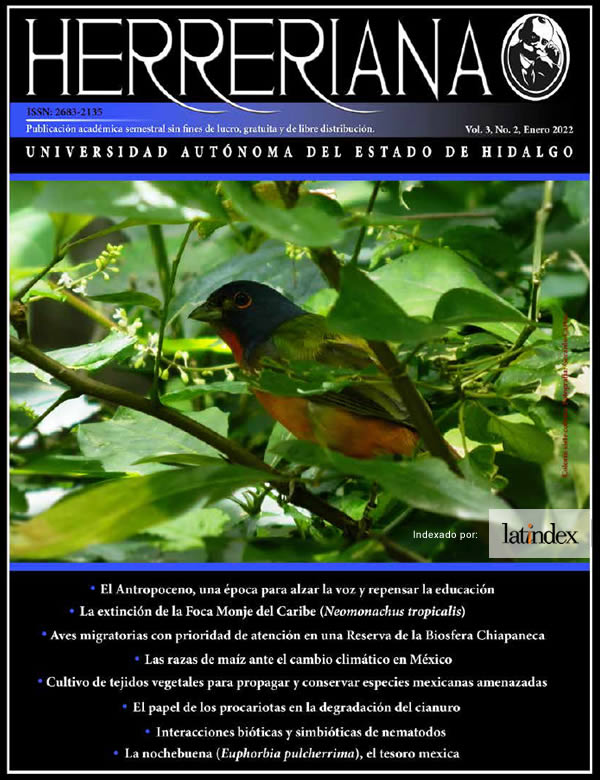The role of prokaryotes in cyanide degradation
The role of prokaryotes in cyanide degradation
Abstract
Cyanide is a toxic substance, potentially lethal, whose concentration has increased due to anthropogenic activities, which generates a negative impact on the ecosystem and on the health of the exposed organisms. For a couple of decades a biotechnological process called "bioremediation" has been used, this consists of taking advantage of the metabolic capacities of microorganisms such as bacteria and archaea that degrade or attenuate contaminants such as cyanide and the compounds it forms. The present work aims to identify the main species of bacteria and archaea with the capacity to degrade cyanide in its different forms, through a bibliographic analysis. Among the microorganisms used for the degradation of cyanide are Bacillus sp., Escherichia coli, Pseudomonas fluorescens, among other species. Based on the number of species described and their efficient removal rates, the cyanide bioremediation process was found to be a promising alternative. In addition, there is a greater biodegradation in the aerobic process compared to the anaerobic process.
Downloads
References
Adjei, M. D. y Ohta, Y. 1999. Isolation and characterization of a cyanide-utilizing Burkholderia cepacia strain. World Journal of Microbiology and Biotechnology, 15: 699-704. https://doi.org/10.1023/A:1008924032039
Calisaya, C. J. y Castillo, C. D. 2020. Aislamiento y capacidad degradadora de cianuro de Klebsiella sp. de la Planta de Tratamiento de Aguas Residuales de Magollo, Tacna - Perú. Ciencias, 4: 37-44. DOI: https://doi.org/10.33326/27066320.2020.4.985
Gail, E., Gos, S., Kulzer, R., et al. 2004. Cyano Compounds, Inorganic. Ullmann’s Encyclopedia of Industrial Chemistry, 10: 1-35. Recuperado de: https://doi.org/10.1002/14356007.a08_159.pub2
Garzón, M. J., Rodríguez, M. J. P. y Hernández, G. C. 2017. Aporte de la biorremediación para solucionar problemas de contaminación y su relación con el desarrollo sostenible. Revista Universidad y Salud, 19: 309-318. DOI: http://dx.doi.org/10.22267/rus.171902.93
Luque, A. V. M., Cabello, P., Sáez, L. P., et al. 2018. Exploring anaerobic environments for cyanide and cyano-derivatives microbial degradation. Applied Microbiology and Biotechnology, 102 (3): 1067–1074. https://doi.org/10.1007/s00253-017-8678-6
Mekuto, L., Ntwampe, S. K. O. y Mudumbi, J. B. N. 2018. Microbial communities associated with the co-metabolism of free cyanide and thiocyanate under alkaline conditions. 3 Biotech 8, 93 (2018). https://doi.org/10.1007/s13205-018-1124-3
Rodallega, S. 2015. Aislamiento y caracterización de bacterias capaces de degradar cianuro presentes en tanques de almacenamiento de cianuro en una mina de oro en el municipio de Buenos Aires, Cauca. Tesis de licenciatura. Universidad Icesi, Santiago de Cali. Recuperado de: https://repository.icesi.edu.co/biblioteca_digital/bitstream/10906/78791/1/rodallega_aislamiento_caracterizacion_2015.pdf
Virender K., Vijay K. y Tek Chand, B. 2013. In vitro cyanide degradation by Serretia marcescens RL2b. International Journal of Environmental Sciences, 3 (6): 1969-1979. https://citeseerx.ist.psu.edu/viewdoc/download?doi=10.1.1.1045.9316&rep=rep1&type=pdf
Zagrobelny, M. y Møller, B. L. 2011. Cyanogenic glucosides in the biological warfare between plants and insects: The Burnet moth-Birdsfoot trefoil model system. Phytochemistry, 72: 1585–1592. DOI: 10.1016/j.phytochem.2011.02.023











